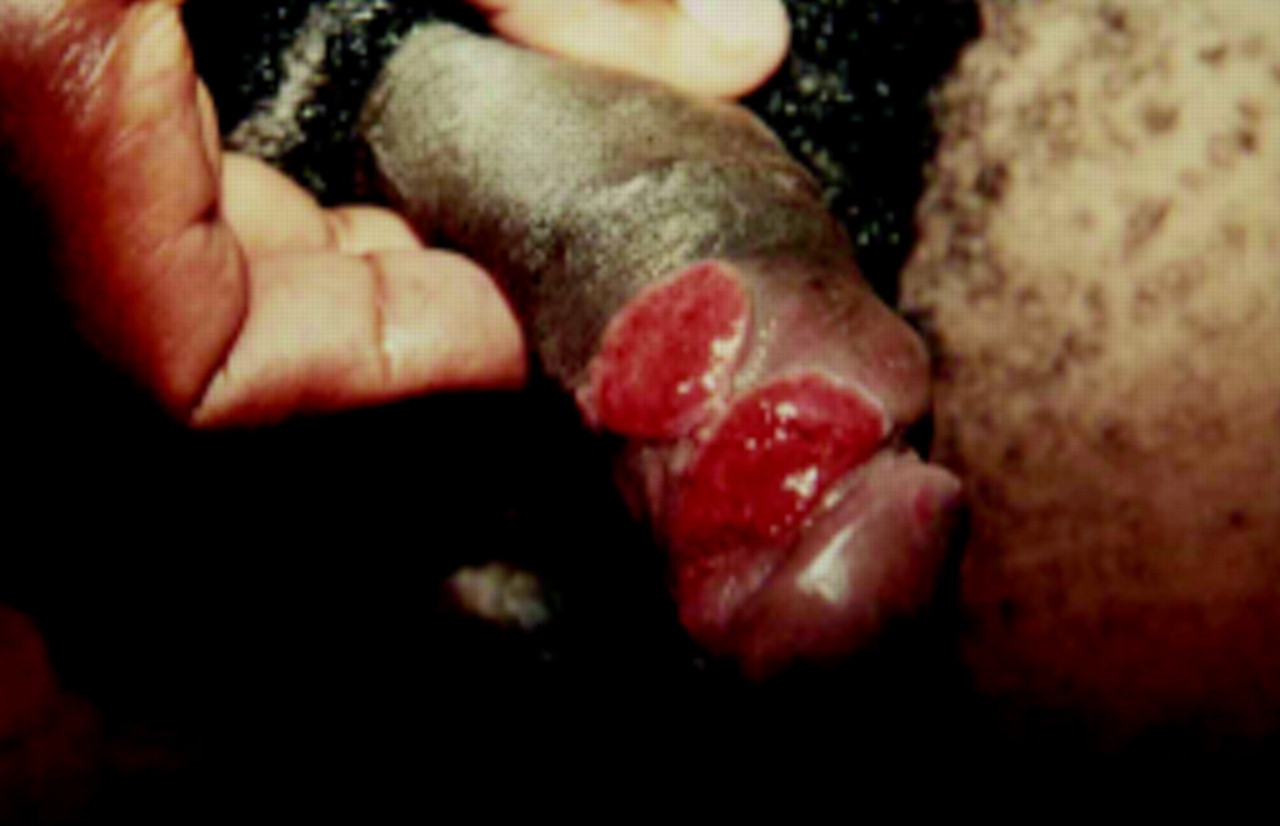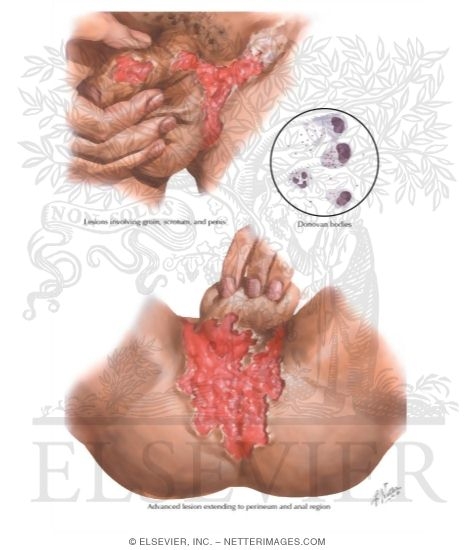Donovanosis (granuloma Inguinale) | Granuloma Inguinale And Hiv A Unique Presentation And Novel Treatment Regimen Journal Of The American Academy Of Dermatology
The majority of cases are acquired by sexual con- Case 1 tact b u t instances. Erreger ist Klebsiella granulomatosis früher als Calymmatobacterium granulomatis oder als Donovania granulomatis bezeichnet ein umkapseltes gramnegatives Stäbchen su.
Granuloma inguinale is a bacterial disease caused by Klebsiella granulomatis characterized by genital ulcers.

Donovanosis (granuloma inguinale). Donovanosis also known as granuloma inguinale is an STD caused by Klebsiella granulomatis and is mainly seen in tropical regions. Granuloma Inguinale Donovanosis Related Pages. 1 Alternative phylogenetic analyses have argued in favour of retaining the previous species name.
It typ- ically manifests as an indolent bright red velvety CASE REPORTS lesion of genital skin or mucosa. Donovanosis or granuloma inguinale is caused by infection with Klebsiella granulomatis formerly known as Donovania granulomatis and Calymmatobacterium granulomatis and was recently renamed following comparative DNA sequencing studies. Granuloma Inguinale Donovanosis is a bacterial infection that causes sores on the genitals.
Extragenital infection can occur with extension of infection to the pelvis or. Subcutaneous granulomas pseudobuboes also might occur. Donovanosis granuloma inguinale is caused by the bacterium Klebsiella granulomatis.
However sporadic cases have been described in India South Africa and. The disease is commonly found in tropical and subtropical areas such as southeast India Guyana and New Guinea. Granuloma Inguinale Donovanosis Granuloma inguinale donovanosis is a genital ulcerative disease caused by the intracellular gram-negative bacterium Klebsiella granulomatis formerly known as Calymmatobacterium granulomatis.
Donovanosis is considered a sexually transmitted disease that is endemic in tropical and subtropical regions of the world. Bei Männern tritt die Donovanosis etwa doppelt so häufig auf wie bei Frauen. Granuloma inguinale or donovanosis is a chronic histology and pathogenesis are discussed and the ulcerative lesion caused by Calymmatobacterium gran- literature is reviewed.
Donovan bodies with the typical safety pin appearance were demonstrated by a Giemsa stained. Phylogenetic analysis confirms close similarities between Calymmatobacterium granulomatis and the genus Klebsiella and a proposal has been made that the infective agent be reclassified as Klebsiella. Ulomatis a gram-negative intracellular bacillus.
It is also called donovanosis after Donovan bodies which are cellular components that are seen when scrapings from the genital skin lesions are viewed under a microscope. Its known as an STI or sexually transmitted infection. Histologic examination revealed mildly acanthotic surface squamous epithelium with underlying granulation tissue containing plasma cells lymphocytes pockets of neutrophils and scattered histiocytic cells.
The authors present images of two of the most common clinical forms of granuloma inguinale donovanosis in males and females. Nicht zu verwechseln mit. Granuloma inguinale is a sexually transmitted infection STI caused by the bacteria previously classified as Calymmatobacterium granulomatosis and now reclassified as Klebsiella granulomatis.
Donovanosis Granuloma inguinale is a mildly contagious chronic progressively destructive infection caused by Klebsiella granulomatis formerly Calymmatobacterium granulomatis a Gram-negative intracellular bacillus. Granuloma inguinale is characterized by intracellular inclusions in. Die Donovanosis ist eine durch das Bakterium Klebsiella granulomatis ausgelöste sexuell übertragbare Erkrankung STD.
This is the first reported case of a combination of two variants of donovanosis in one individual. Donovanosis occurs in tropical countries including Papua New Guinea and the majority. Taxonomisch wird der Erreger den Klebsiellen zugeordnet.
Doxycycline 100 mg orally 2 timesday for at least 3 weeks and until all lesions have completely healed. The condition is characterized by chronic progressive ulcerating disease mostly affecting the genital region. Azithromycin 1 g orally once weekly or 500 mg daily for 3 weeks and until all lesions have completely healed.
Dabei entstehen chronische Ulzerationen im Genitalbereich. Clinically granuloma inguinale or donovanosis is commonly characterized as painless slowly progressive ulcerative lesions on the genitals or perineum without regional lymphadenopathy. The disease occurs rarely in the United States.
Two microscopic images are also shown one of a direct smear the presence of Donovan bodies within large mononuclear cells identified using. Donovanosis granuloma inguinale is a rare cause of genital ulceration that is close to global eradication. The lesions are highly vascular ie beefy red appearance and bleed.
It is also known as donovanosis granuloma genitoinguinale granuloma inguinale tropicum granuloma venereum granuloma venereum genitoinguinale lupoid form of groin ulceration serpiginous ulceration of the groin ulcerating. Donovanosis or granuloma inguinale is described by the Centers for Disease Control and Prevention CDC as a genital ulcerative disease caused by a bacterium called Klebsiella granulomatis. There is debate about the nomenclature of the causative organism.
The most recent case was notified in 2014. Donovanosis granuloma inguinale Donovanosis granuloma inguinale is a sexually transmitted disease that is rarely seen in the United States. Die Donovanosis-Fälle hierzulande sind meist durch Reisen in Gebiete bedingt in denen das Granuloma inguinale häufig vorkommt oder aber die Erkrankungen werden durch Einwanderer nach Deutschland gebracht.
It is endemic in many less-developed regions. Donovanosis or granuloma inguinale is caused by infection with Klebsiella granulomatis formerly known as Donovania granulomatis and Calymmatobacterium granulomatis and was recently renamed. Granuloma inguinale is a chronic bacterial infection that frequently is associated with other sexually transmitted diseases.

Granuloma Inguinale Plastic Surgery Key

Donovanosis Sexually Transmitted Infections

Granuloma Inguinale Infectious Diseases Merck Manuals Professional Edition

Granuloma Inguinale And Hiv A Unique Presentation And Novel Treatment Regimen Journal Of The American Academy Of Dermatology

Granuloma Inguinale Dermnet Nz

Clinical Presentation Of Granuloma Inguinale Donovanosis

Donovanosis Granuloma Inguinale Causes Symptoms Diagnosis Treatment

Granuloma Inguinale By Lazoithelife Issuu

Donovanosis Sexually Transmitted Infections

Scielo Brasil Donovanosis Sup Sup Donovanosis Sup Sup

Granuloma Inguinale And Its Treatments

Donovanosis An Incidental Finding On Pap Test Wahal Sp Tuli D J Cytol

Granuloma Inguinale Donovanosis Diagram

Granuloma Inguinale Dermnet Nz

Malignant Transformation Of Donovanosis Granuloma Inguinale In A Hiv Postive Patient

Chancroid Lymphogranuloma Venereum Granuloma Inguinale Genital Herpes Simplex Infection And Molluscum Contagiosum Sciencedirect

Granuloma Inguinale Donovanosis American Urological Association


